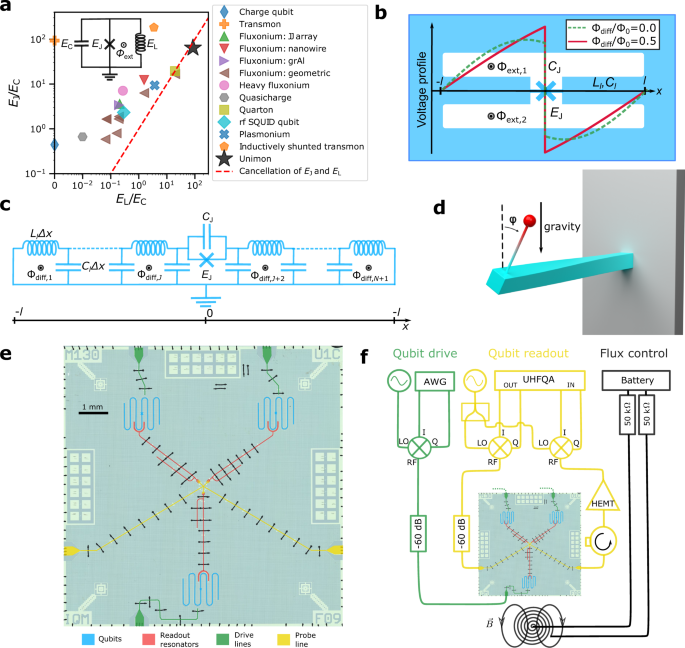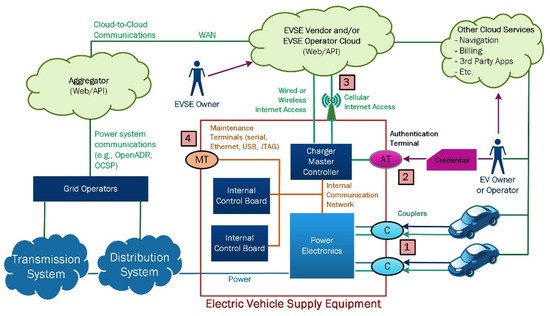量子計算の精度を高めるための新しい超伝導量子ビット「ユニモン」を発見した。 A group of scientists from Aalto University, IQM Quantum Computers, and VTT Technical Research Centre of Finland have discovered a new superconducting qubit, the unimon, to increase the accuracy of quantum computations
2022-11-15 フィンランド・アールト大学
非調和性の向上、直流電荷ノイズの完全不感性、磁気ノイズの感度の低減、共振器内の単一のジョセフソン接合のみのシンプルな構造という望ましい特性を一つの回路にまとめた新しいタイプの超伝導量子ビット「ユニモン」を発表した。研究チームは、3種類のユニモン量子ビットを用いた13ナノ秒の単一量子ビットゲートにおいて、99.8%から99.9%の忠実度を達成した。
研究者たちは、ユニモンを実験的に実証するために、3つのユニモンで構成されるチップを設計し、製造した。超伝導材料にはニオブを使用し、ジョセフソン接合にはアルミニウムを使用して超伝導リードを作製した。
研究チームは、超伝導体を用いずジョセフソン接合1つで構成しながら、比較的高い非調和性を持つユニモン量子ビットを測定し、ノイズ対策に耐えられることを確認した。ユニモンの幾何学的インダクタンスは、従来のフラクソニウムやクアートン量子ビットの接合アレイ型超伝導体よりも高い予測可能性と収率を実現する可能性を持っている。
<関連情報>
- https://www.aalto.fi/en/news/unimon-a-new-qubit-to-boost-quantum-computers-for-useful-applications
- https://www.nature.com/articles/s41467-022-34614-w
ユニモン量子ビット Unimon qubit
Eric Hyyppä,Suman Kundu,Chun Fai Chan,András Gunyhó,Juho Hotari,David Janzso,Kristinn Juliusson,Olavi Kiuru,Janne Kotilahti,Alessandro Landra,Wei Liu,Fabian Marxer,Akseli Mäkinen,Jean-Luc Orgiazzi,Mario Palma,Mykhailo Savytskyi,Francesca Tosto,Jani Tuorila,Vasilii Vadimov,Tianyi Li,Caspar Ockeloen-Korppi,Johannes Heinsoo,Kuan Yen Tan,Juha Hassel & Mikko Möttönen
Nature Communications Published:12 November 2022
DOI:https://doi.org/10.1038/s41467-022-34614-w

Abstract
Superconducting qubits seem promising for useful quantum computers, but the currently wide-spread qubit designs and techniques do not yet provide high enough performance. Here, we introduce a superconducting-qubit type, the unimon, which combines the desired properties of increased anharmonicity, full insensitivity to dc charge noise, reduced sensitivity to flux noise, and a simple structure consisting only of a single Josephson junction in a resonator. In agreement with our quantum models, we measure the qubit frequency, ω01/(2π), and increased anharmonicity α/(2π) at the optimal operation point, yielding, for example, 99.9% and 99.8% fidelity for 13 ns single-qubit gates on two qubits with (ω01, α) = (4.49 GHz, 434 MHz) × 2π and (3.55 GHz, 744 MHz) × 2π, respectively. The energy relaxation seems to be dominated by dielectric losses. Thus, improvements of the design, materials, and gate time may promote the unimon to break the 99.99% fidelity target for efficient quantum error correction and possible useful quantum advantage with noisy systems.



